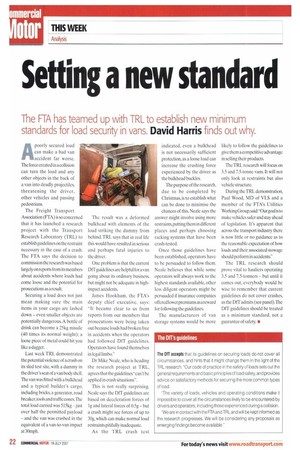Setting a new standard
Page 22

If you've noticed an error in this article please click here to report it so we can fix it.
The FTA has teamed up with TRL to establish new minimum standards for load security in vans. David Harris finds out why.
Apoorly secured load can make a bad van accident far worse. The force created in a collision can turn the load and any other objects in the back of a van into deadly projectiles, threatening the driver, other vehicles and passing pedestrians.
The Freight Transport Association (FTA) is so concerned that it has launched a research project with the Transport Research Laboratory (TRL) to establish guidelines on the restraint necessary in the case of a crash. The FTA says the decision to commission the research was based largely on reports from its members about accidents where loads had come loose and the potential for prosecutions as a result.
Securing a load does not just mean making sure the main items in your cargo are lashed down — even smaller objects are potentially dangerous A bottle of drink can become a 25kg missile (40 times its normal weight); a loose piece of metal could hit you like a dagger.
Last week TRL demonstrated the potential violence of a crash on its sled test site, with a dummy in the driver's seat of a van body shell. The van was fitted with a bulkhead and a typical builder's cargo, including bricks a generator, road brealcer,tools and traffic cones The total load carried was 515kg —just over half the permitted payload — and the van was crashed in the equivalent of a van-to-van impact at 30mph. The result was a deformed bulkhead with elements of the load striking the dummy from behind. TRL says that in real life this would have resulted in serious and perhaps fatal injuries to the driver.
One problem is that the current DfTguidelines are helpful for a van going about its ordinary business, but might not be adequate in highimpact accidents.
James Hookham, the FTA's deputy chief executive, says: It became clear to us from reports from our members that prosecutions were being taken out because loads had broken free in accidents when the operators had followed D1T guidelines, Operators have found themselves in legal limbo."
Dr Mike Neale, who is heading the research project at TRL, agrees that the guidelines"can't be applied in crash situations".
This is not really surprising. Neale says the DfT guidelines are based on deceleration forces of I g and lateral forces of 0.5g — but a crash might see forces of up to 30g, which can make normal load restraints pitifully inadequate.
As the TRL crash test indicated, even a bulkhead is not necessarily sufficient protection, as a loose load can increase the crushing force experienced by the driver as the bulkhead buckles.
The purpose of the research, due to be completed by Christmas, is to establish what can be done to minimise the chances of this. Neale says the answer might involve using more restraints,putting them in different places and perhaps choosing racking systems that have been crash-tested.
Once those guidelines have been established, operators have to be persuaded to follow them. Neale believes that while some operators will always work to the highest standards available, other less diligent operators might be persuaded if insurance companies offered lower premiums as a reward for following the guidelines The manufacturers of van storage systems would be more likely to follow the guidelines to give them a competitive advantage in selling their products.
The TRL research will focus on 3.5 and 7.5-tonne vans. It will not only look at restraints but also vehicle structure.
During the TRL demonstration, Paul Wood, MD of VLS and a member of the ETA's Utilities Working Group,said:"Our goal is to make vehicles safer and stay ahead of legislation. It's apparent that across the transport industry there is now little or no guidance as to the reasonable expectation of how loads and their associated stowage should perform in accidents."
The TRL research should prove vital to hauliers operating 3.5 and 7.5-tonners — but until it comes out, everybody would be wise to remember that current guidelines do not cover crashes, as the Dff admits (see panel).The DfT guidelines should be treated as a minimum standard, not a guarantee of safety.


























































































































































































